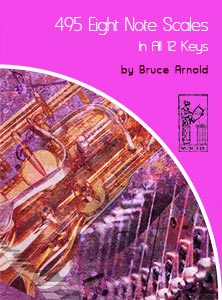
495 Eight Note Scales in all 12 keys
Bruce Arnold’s “495 Eight Note Scales in all 12 keys” course covers the 495 possible eight note scales and gives you that information in all 12 keys. This is pretty unheard of as far as a published lexicon of eight note scales. While most musicians are familiar with the common octatonic scales of diminished many times they overlook a few facts about eight note scales.
First, I think the most important thing to realize you can take any scale that is commonly used over a dominant chord and add one more note to this scale. This added note would be one of the 6 available tensions. There are a few common examples of this like using this scale as a replacement for a G7 chord: G,Ab,Bb,B,C,D,Eb,F which is like a G mixolydian b2,b6 scale with an added Bb. There are tons of other possibilities which are all covered in this course.
To get into the specifics “495 Eight Note Scales in all 12 keys” looks at of course the 495 octatonic scales but also includes their internal structure, which chords they can be played over and much more information to help you organize your study. The interesting this is that all of these 495 possible eight note scales can be reduced down the 29 prime forms using pitch class set theory that can be helpful when you are organizing how these octatonic scales interrelate but also help in their memorization.
In the 495 Eight Note Scales in all 12 keys I’ve also include references to these prime forms throughout the course. The pitch class set theory information is by no means crucial to working with this course but over time I’m sure you will see its usefulness. I’ve written another book called “Sonic Resource Guide.” if you want to learn more about pitch class set theory and how it can be used by an improvising musician.
Since most musicians aren’t aware of the use of octatonic scales I’ve Included in the “495 Eight Note Scales in all 12 keys” course a list of compositions by various composers who have used octatonic scales. I think it’s important to listen to some of this music to give you ideas and inspiration. I would also recommend you check out the music and improvisations of guitarist Alan Holdsworth. Mr. Holdsworth’s use of octatonic scales in his compositions and improvisations is one of the reasons his music sounds so different.
“495 Eight Note Scales in all 12 keys” also contains a list of the two tetrad (4 note) chords that form the complete eight note scale. This is a highly useful list that shows the Two Tetrad combinations for the 29 possible pitch class sets. This list again comes from the “Sonic Resource Guide” which I mentioned earlier. The Two Tetrad list is a great technique for finding two chords that can be used to make up a octatonic scale but also is a great improvisational technique in itself which I highly recommend.
You can purchase this course in a few ways.
Purchase at Muse Eek Publishing Inc.
Purchase at Bruce Arnold’s Patreon Site
Below is a list of the table of contents from the “495 Eight Note Scales in all 12 keys”course
Table of Contents:
Composers and Musicians that have used Octatonic Scales 495 Eight Note Scales How to Work with this Course “Derivative” Composition Chords and Available Tensions Ways to Implement Diatonic Octatonic Chords 495 Eight Note Scales with Prime Form Diatonic Chords of Eight Note Scales Diatonic Chords of the Key of C Conclusion
List of Contents for 495 Eight Note Scales Course:
Bruce Arnold Music Education Genealogy Chart
You might enjoy checking out the “Music Education Genealogy Chart” located on my artist’s site. You will clearly see the historic progression of pedagogy that is the basis for Muse Eek Publishing Products. Great musicians throughout history have been studying the ideas presented by Muse-eek.com which derives its content from a a lineage that stretches back to Scarlatti!

